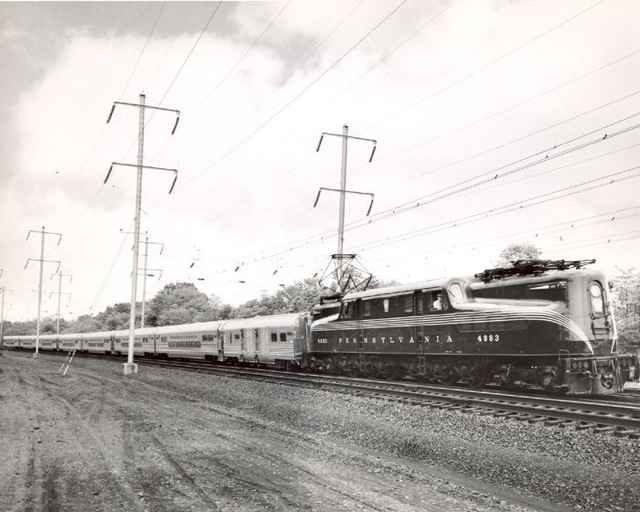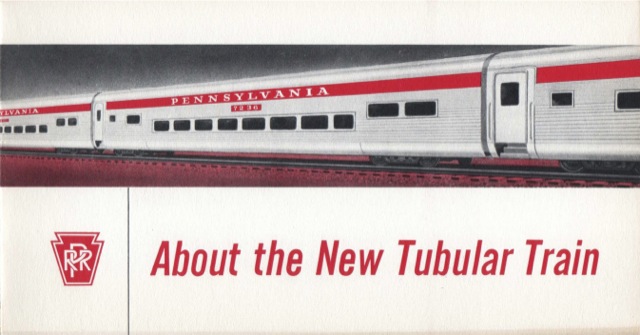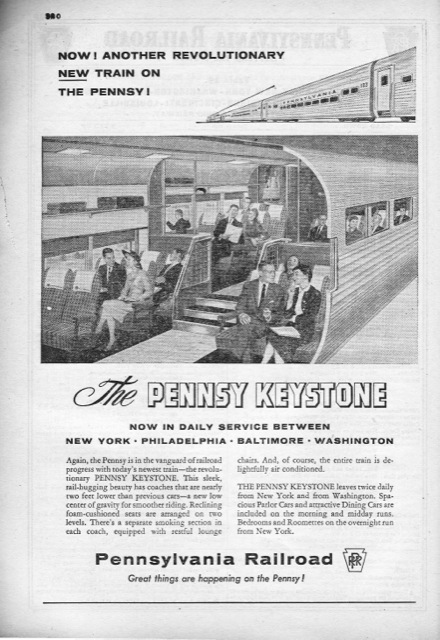On June 24, 1956, the Pennsylvania Railroad inaugurated the Keystone, a twice-daily Washington-New York train that used a new design of coaches built by Budd. The floors at the ends of the cars were of normal height so that doorways matched the platforms that existed at every station along the route. But in keeping with the Talgo low-floor philosophy, the centers of the cars were lowered, reducing the car’s center of gravity.
This brochure describes the supposed advantages of a train with a lower center of gravity. There is no date but the brochure was printed well before the cars were completed. The actual cars did not have a red stripe, and the word “Pennsylvania” was in raised letters at the same height as the end windows. The cars were numbers in the 9600s and the numbers, in raised letters, appeared on the ends of the cars at the same height as the railroad name. Click image to download a 1.5-MB PDF of this four-page brochure.
The lower center of gravity supposedly allowed the train to take curves at higher speeds without worries the cars would tip over. For some reason, Budd and Pennsylvania called this a “tubular train,” as if all normal steel passenger cars were not, in some sense, tubes.

This is a mockup of a train car, no doubt at Budd’s plant in Pennsylvania. The end of the car is a smoking lounge while the center is for non-smokers.
The train consisted of seven coaches, each with 82 seats, and an eighth car to generate electricity for the coaches. The total height of the cars was just 11 feet 9 inches, compared with 13 feet 6 inches for a normal streamlined coach. Each car was 85 feet long, the same as a normal car, but partly because of the lower height the cars weighed only 93,000 pounds instead of the 123,000 pounds that a normal coach would weigh. Budd said the train cost about $2,000 per seat, compared with $3,000 for a conventional train but $1,000 for the Aerotrain.

The Keystone train pulled by a Pennsylvania GG1 locomotive. The power car is the first car behind the locomotive. In regular service, a diner, parlor car, and in the case of an overnight train, sleeping cars would be behind the coaches. Click image for a slightly larger view.
The lower weight claims were something of a cheat, however, because the power car allowed Budd to dispense with the heavy batteries and generators used in normal passenger cars. Dividing the weight of the power car up among the other seven coaches must have made up a substantial portion of the 30,000-pound difference between each Keystone coach and a normal coach. Ironically, considering that there was plenty of power in the overhead wires on this route, a separate power car was unnecessary, but Pennsylvania was no doubt thinking of running the train on other routes at some point in the future.
This advertisement probably appeared in Railway Age. Click image for a larger view.
Since all the cars on the tubular train were coaches, the train was normally run with diners, lounges, and (in the case of the overnight train) sleeping cars of normal height. Of course, this negated any speed advantage from running cars with a lower center of gravity. The average speed from Washington to New York was about 60 mph, similar to the average speeds attained by many streamliners.
In the 1950s, having a sunken living room or conversation pit was considered the height of fashion. But having to repeatedly step down three steps and then up three steps in every car on the way to the diner or some other car was a major annoyance, and passengers did not appreciate the design. Still, because the cars were on four-wheel trucks instead of the two wheels of the Talgo and Aerotrains, the ride wasn’t any worse, if not any better, than that of an ordinary train. The Keystone remained in operation for a dozen years, then was replaced about the time the Metroliners were introduced.



I need to make some clarifications and explanations here.
The point of the tubular design is that the roof and walls form a single structural arch, as opposed to a traditional design where the sides support a flat roof, as in a typical house. This can be seen in the pictures as the roof curves smoothly into the sides, as opposed to traditional streamlined stock where there is an edge/corner where the two meet.
The resulting weight reduction and strength increase means that a lighter undercarriage can be used. As a result, there was indeed a substantial structural improvement and they were fundamentally lighter as a result.
The basic “tubular” principle is sound, and was used on the Pioneer III and Silverliner II commuter rail cars around Philadelphia. The Silverliner II lasted in service until roughly 2009, only retiring due to worn-out mechanicals, old seats, and poor acceleration (relative to new equipment). The basic frames were as sound as anything that Budd built. I seem to recall that the Santa Fe Hi-Levels used the tubular design to a degree.
The reason for the separate power car was because the Keystones were among the first trains to be built with HEP systems. This, as you noted, enabled the generators and batteries to be removed, along with the steam heating and the like. However, it did create the need for the separate power car, since the GG1 was never equipped to transmit the electricity for HEP power. All of the passenger GG1 fleet remained with steam heat until the end of their service. When they hauled Amfleet trains in the latter days of their careers, they needed power cars again for the same reason.
Really, the only issue with the Keystone was the incredibly stupid decision to have the split floor level.